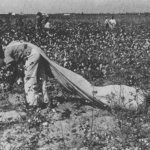The American eighteenth and nineteenth century was a time period in which industrialization and innovation flourished. These years followed a time of colonization which was crucial for the foundation of America. The nation experiences a shift from a farming centered economy, to an industrial one, which magnified the production of goods and services; in return, profits of these sales and the economy grew exponentially. Two inventions, the cotton gin by Eli Whitney in 1794[1], and the Steam Engine by James Watt and Matthew Boulton in 1769[2], paved the way for exponential development of the Industrial Revolution[3]. A Steam-engine Cotton-gin was a new piece of technology that came about in 1873 by combining these two invention; it advanced the production of cotton at rapid rates, quickly making the machine a global necessity. Further significance of the Steam-engine Cotton-Gin is discovered through appreciation of the steam-engine design process.
During the Industrial Revolution, the invention of individually working mechanical parts was the start of creations such as the Steam-engine Cotton-gin. The Watt-Boulton Steam-Engine was one of the first to combine these parts, such as the brass cylinder which, after much trial and error experimentation, was implemented into the design[4]. In this time period, experimenting with a project that large scale was risky for many reasons, primarily because investors, like Roebuck, went bankrupt trying to sponsor the build. Nonetheless, Watt tested an even greater number of solutions than there were problems[5]. Even when comparing the Steam-engine Cotton-gin to the original steam-engine, the engine of the new machine contained enough horsepower to drive two gins, making the possibilities endless[6]. The technologies proposed by Watt and Boulton aided in what became an easier and quicker way to complete daily tasks.
Solo, a cotton gin proved to be “fifty times more productive than a hand laborer” which is why cotton soon became the most profitable crop produced by America[7]. Consequently, the increased demand for cotton directly correlated with the need for black labor, typically in the form of slaves. Almost solely due to the increased cotton production by the cotton-gin, slave population in America increased eight percent in under fifty years. The demand for such a powerful increase in workers can be seen globally, as the textile industry boomed in Great Britain from the imports of cotton from America[8]. Undeniably, a great deal of success correlated with the Industrial Revolution rested upon the hands of the hard working black labor that made it all possible.
- Hand-picking cotton remained the dominant method of cotton collection throughout the Cotton Belt, even with inventions like the cotton gin and steam engine gaining popularity.
- Cotton picked primarily by slaves was then transported via wagon to the location of the cotton gin.
To further the scene during the seventeen and eighteen hundreds, picture acres of planted cotton fields. Because of inventions like the steam-engine cotton-gin, farmers planted hundreds of acres of cotton crop, rather than just ten acres that was maintainable by hand[9]. The workload and sheer scale of this increase is simply hard to comprehend in terms of the job that workers, primarily slave, were now responsible for. An area termed the Cotton Belt, was a southern region primarily suitable for massive agricultural propagation of cotton crop[10]. Although innovational advancements made processing larger crop sizes possible, picking cotton was a tedious and back-breaking labor.
[1] Eli Whitney’s Cotton Gin Patent Drawing
[2] Industrial Revolution
[3] Who Invented the Steam Engine?
[4] Invention and Innovation in the Watt-Boulton Steam-Engine Venture
[5] Invention and Innovation in the Watt-Boulton Steam-Engine Venture
[6] Steam-engine Cotton-gin
[7] An Expanding Nation
[8] The Other Side of Slavery: Black Labor
[9] The Broken Cotton Belt
[10] The Rise of the Cotton Belt


